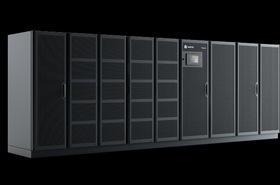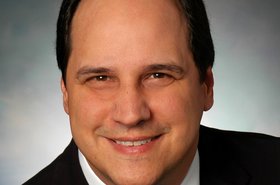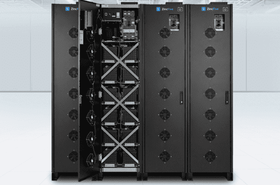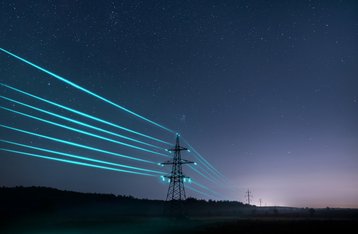Not a day goes by without further evidence that the world’s power infrastructure is under severe strain. While the storm of uneven AI workloads grabs much of the attention, it has simply compounded an inconvenient truth – we need more data, which means more data centers, which require more power. This has led to restrictions from energy providers in some territories, which are only likely to increase as we come to terms with the twin pressures of increased demand and the need to embrace more sustainable ways of producing it.
With full support for the power sources of the future, Vertiv has launched its new Vertiv Trinergy UPS. This system combines modular hardware with software and monitoring capabilities to optimize power quality, backup power, and cooling performances – all backed up by service and expertise to bring the right solution to every facility.
DCD met up with Arturo Di Filippi, offering director of global large power at Vertiv, to examine industry challenges and discuss potential solutions. He tells us:
“We are witnessing the dawn of a new era. Previously, data centers grew significantly, driven mainly by cloud or colo applications, and the load was steady. Now, with AI, the landscape has changed completely. The load is no longer steady but varies greatly depending on the AI application and scenario.”
Although the issue is often associated with AI, data center operators face similar challenges regardless of their load types. Every new data center requires power, and there often isn’t enough to meet the demand. Di Filippi adds:
“New data centers are a result of AI, but power constraints are related to availability. These constraints apply to both flexibility and AI applications, as their loads can fluctuate significantly in a short time. Some grid operators may need those megawatts at short notice. As an equipment supplier, we need to consider how we can support this because the grid needs to remain steady. One way we can do this is by using uninterruptible power supply (UPS) units that function as power centers. These units can interact with the grid for frequency balancing while supporting the volatile critical load.”
AI is a highly unpredictable commodity with workloads that constantly ebb and flow, making it challenging to quantify global demand accurately. Businesses like Vertiv must use their expertise to make informed forecasts about requirements. Simultaneously, they must prepare for worst-case scenarios, reflecting data transfer's "always on" nature.
As Di Filippi explains, the focus has broadened from solely environmental responsibility two years ago to now also prioritizing reliable power for data centers in the age of AI. This challenge has highlighted a sense of urgency: “A couple of years ago, we were only talking about reducing our carbon footprint, and how our products could set the stage for meeting decarbonization goals. The discussion has evolved to include AI and securing power for its workloads, regardless of the source. That's why we need to be good at merging both goals and support most of the power used with more eco-friendly options wherever possible.
“Vertiv unveiled its first UPS and fuel cell integration at the new Customer Experience Center in Delaware, OH, setting a benchmark for low-carbon backup power solutions. Additionally, Vertiv has formed a strategic partnership with Ballard Power Systems, a leader in PEM fuel cells. Together, they aim to offer scalable, cost-effective fuel cell backup power solutions for data centers. These solutions produce zero Green House Gas (GHG) emissions. Initial tests have shown that the zero GHG emission backup power works successfully in an uninterruptible power system.”
Simultaneously, the rapid expansion in the data center industry has forced suppliers to become more agile in production to meet demands while reducing running costs. As facilities retrofit for increased density, demand for more powerful products with a lower footprint grows ever greater, and sometimes trade-offs have to be found, as Di Filippi explains:
“There could be solutions that improve efficiency but may bring disadvantages in terms of footprint. The end goal will be to have both, but in some cases, the most demanded feature is the chance to install within a small footprint, making it even more valuable than adding efficiency. Quality, reliability, and resilience are the most important aspects, but that is baked into everything that we do as standard, so it’s barely worth mentioning – after all, we could deliver the best-performing product in the world, but it’s no good if it doesn’t work as expected – that makes no sense.”
One of Vertiv’s goals with Vertiv Trinergy is to evolve the traditional UPS into a “power center”, enabling the unit to interface with multiple AC/DC energy sources using a different type of fuel. By evolving to new battery standards, such as lithium, nickel-zinc, and other emerging energy storage technologies, they can enhance efficiency and capacity.
Di Filippi tells us: “We need to make sure that we can integrate our products with all the possible energy sources that a customer wants to deploy. Our UPS must be able to interface with all these options without any additional service or maintenance.”
Nickel–zinc batteries are currently more expensive than traditional lithium batteries, which have become more competitive for mainstream use in data centers and consumer products such as electric cars. For data center operators, nickel-zinc is considered a safe battery material for energy storage and represents a viable alternative to lithium-ion when its deployment is in question due to fire safety concerns.
“We still think that lithium is the best option for backup power applications for a combination of performances and TCO. Vertiv lithium batteries are certified, tested, and encased in such a way as to make sure that problems are limited and contained to the battery rack itself, without affecting any other equipment in the data center. Nevertheless, customers usually prefer to adopt a fire suppression system, which is an additional expense on their side. That's why we have extended our energy storage portfolio with nickel-zinc batteries. Performance is close to lithium, but their main advantage is that they don’t have the same safety risks.”
Vertiv Trinergy's modularity concept also extends to integrating energy storage devices to meet customers' individual needs – whether they're fitting out a new data center or retrofitting existing facilities. Optimizing UPS and battery integration helps them fit better in their deployment spaces. This typically results in a smaller footprint for the entire setup. The saved space can then be used for additional racks, liquid cooling, or scaling up backup power. “This concept of modularity extends to distributed batteries, meaning that in case of a fault happening, we can make sure that the fault is limited to the group of batteries connected to one core, while all the others can keep working. Distributed batteries offer improved performance under various failure modes, amplifying UPS performance and ensuring uninterrupted operations in critical power scenarios.”
Additionally, data centers can act as responsible grid citizens by utilizing energy storage systems to provide grid services and help balance the fluctuating demand for electricity. This not only benefits the environment but also provides an additional revenue stream for data centers:
“For AI, we know that load variations can occur. Sometimes we need to support the load during huge spikes, which can be managed through batteries if the customer chooses. Conversely, we offer what we call ‘grid support’. If there is a greater power absorption on the grid or a decrease in grid frequency (for instance, due to renewables not generating as expected because of weather conditions), the grid can request help.
“In that case, the UPS can intervene, disconnect partially from the grid, and use the batteries to support the load, helping to restore the grid frequency. The grid operator will be relieved since the temporary loss of power brough by the intermittent renewables is compensated and grid frequency re-established. In some countries, the data center owner can also receive some revenue from the grid for that.”
Although these trade-offs have come about as a result of the constraints on the power grid, Vertiv remains committed to improving its offerings to be as efficient as possible, both for the benefit of the data center and the planet. Di Filippi explains:
“We can add a lot of themed features like dynamic online and dynamic grid support, which we call operating modes. These can lead to some levels of efficiency that we have not seen before. This is our mindset – our strategy that we also apply to products for launch in the future or extensions of this one.
“We can work in a way that boosts efficiency to 99 percent. And with dynamic grid support, we can make sure that we contribute to sustainability because we encourage the introduction of renewables. After all, the UPS can assist in providing support by the time the grid goes down as an indirect approach to aiding stability. Ultimately, if and when we can work with hydrogen, you will not produce any emissions at all.”
As Di Filippi has explained, Vertiv Trinergy has been designed to integrate with multiple energy sources. As we wrap up, we ask him to future-gaze into what he believes will become the dominant energy sources of an eco-friendlier and AI-enabled data center:
“Batteries are not prime power unless you have some other power source constantly recharging them. The first option is gas turbines. This is something that is already happening. Working with gas is adding emissions, but as a main alternative, that’s the most immediate.
“Hydrogen fuel cells show promise, but current hydrogen production levels aren’t as sufficient for continuous community operation yet. However, the progress we've seen with the UPS and fuel cell integration in the Vertiv Customer Experience Center in Delaware, OH, along with our partnerships with Ballard Power Systems, is encouraging. This indicates that we're moving in the right direction for future advancements.
“You may have also heard about SMR – small nuclear reactors, which are also feasible. You can use wind and solar in, say, a one-gig campus, in countries where there's lots of sun or wind. But for at least two to three years, maybe up to five years we will need to accept that natural gas, while not perfect, has lower emissions coupled with the same performance efficiencies.”
The big takeaway, however, is that whatever the fuels of the future turn out to be, Vertiv Trinergy is on track to becoming a Power Center. This solution will be capable of controlling multiple AC and DC energy sources, regardless of future fuel developments. Meanwhile, its primary mission remains unchanged: to protect the critical load of your data centers and ensure consistent, reliable power quality for AI and other mission-critical applications.
For more information about Vertiv Trinergy, visit the product page or explore its campaign.
More from Vertiv Power
-

Vertiv launches Trinergy UPS system
Targeting high capacity hardware
-

Sponsored Data centers in the age of AI: Insights and strategies
Vertiv pioneers sustainable solutions for data centers, tackling power demands with innovations like liquid cooling and battery storage
-

Vertiv adds ZincFive’s nickel-zinc batteries to UPS offerings
Companies can choose alternative to lead-acid or lithium-ion


